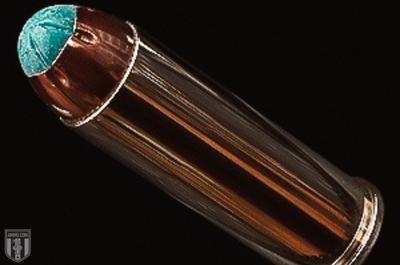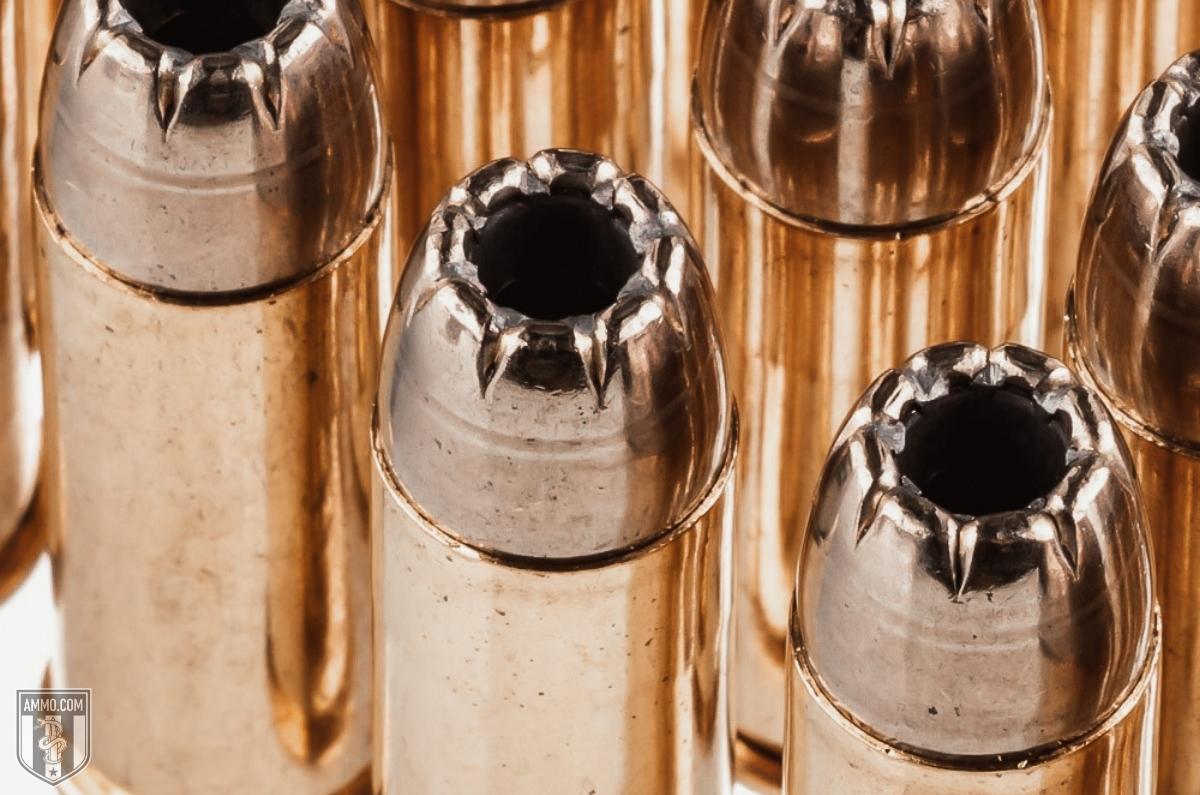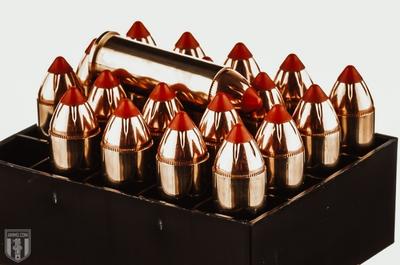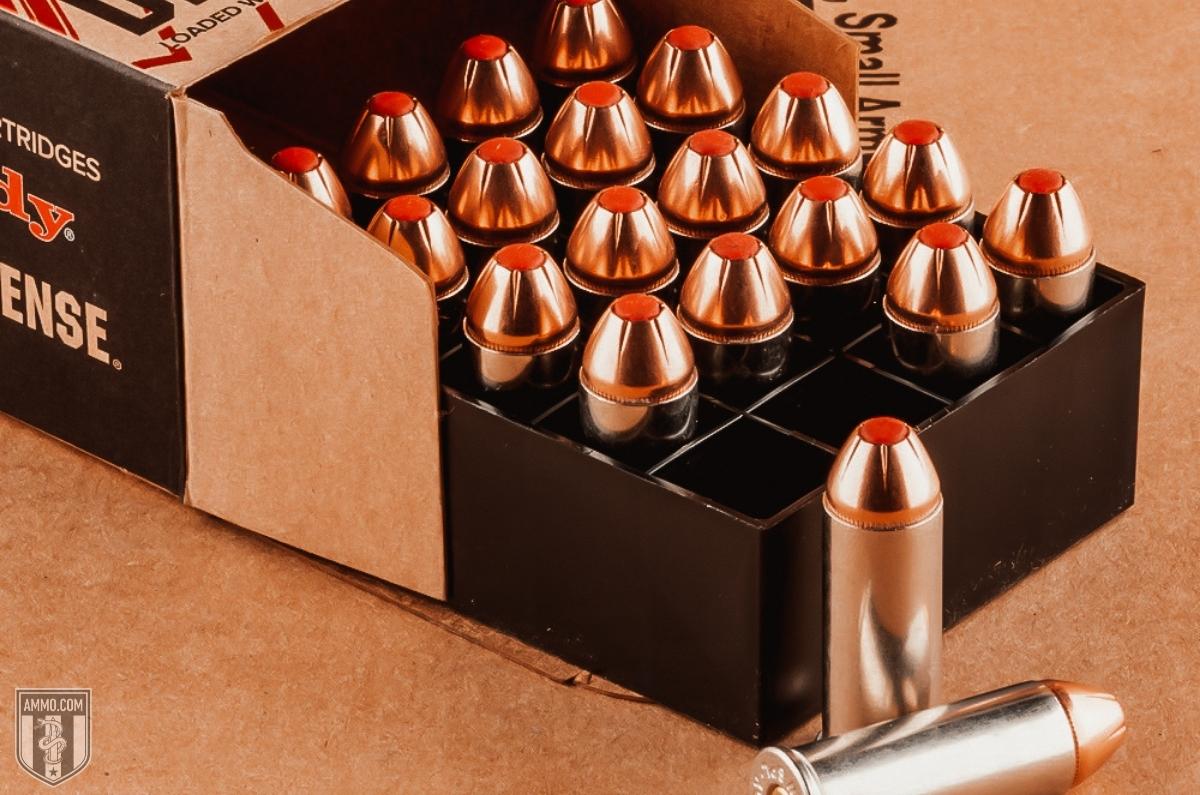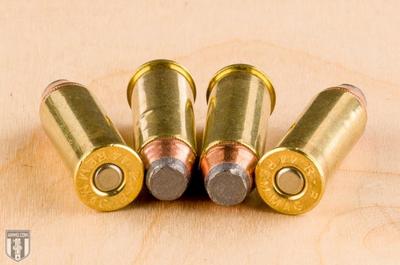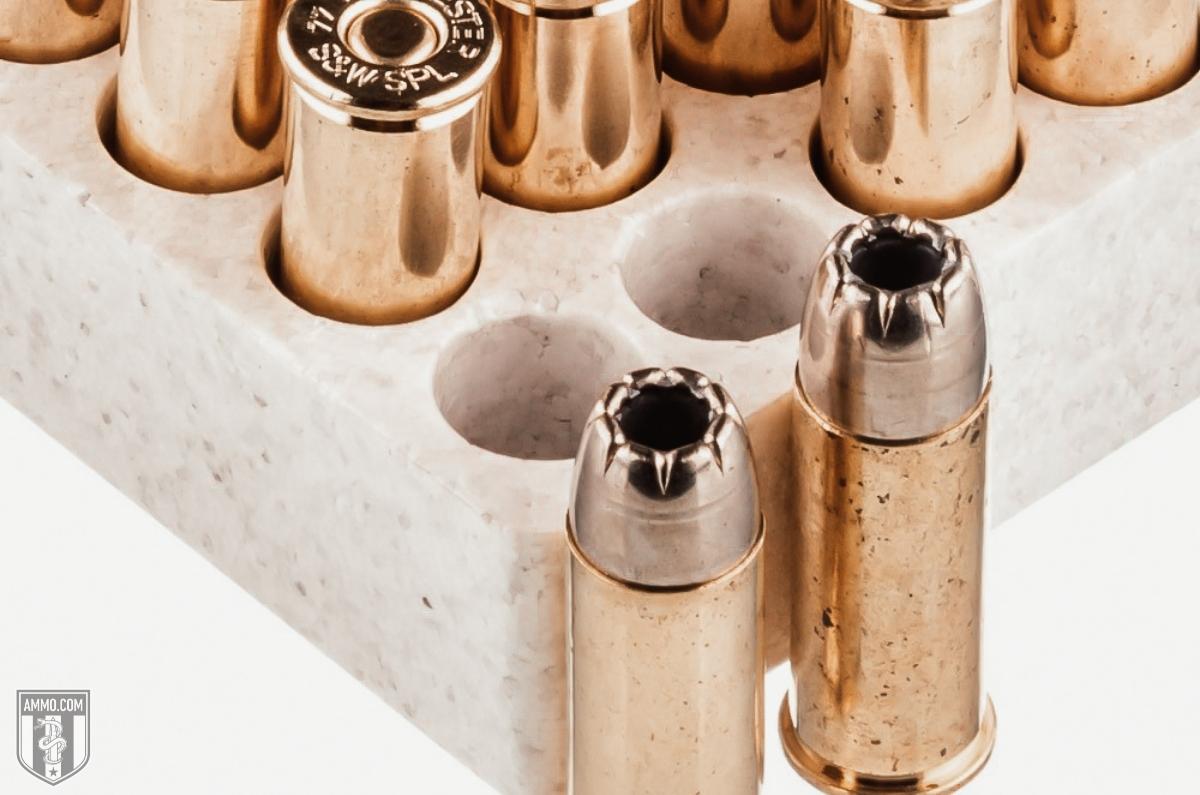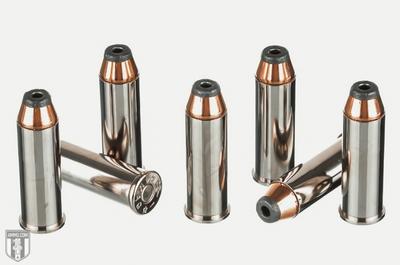44 Special vs 44 Magnum: Battle of the Big Bore Revolvers
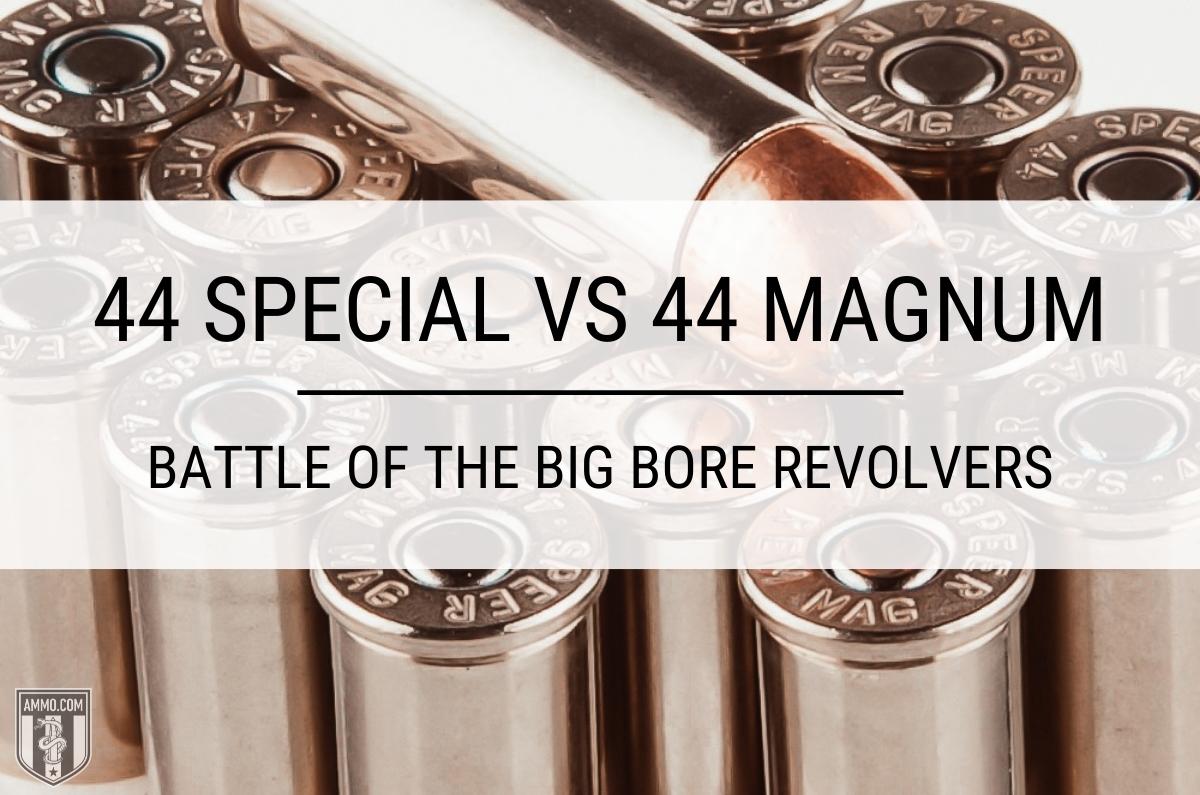 The .44 Smith & Wesson Special is well over a century old. Although insanely popular in the early 20th century, the Special almost went the way of the dinosaur after the introduction of its faster, harder-hitting, and more popular younger brother, the .44 Remington Magnum. The .44 Spl has been mostly kept alive by custom handloaders and cowboy action shooters.
The .44 Smith & Wesson Special is well over a century old. Although insanely popular in the early 20th century, the Special almost went the way of the dinosaur after the introduction of its faster, harder-hitting, and more popular younger brother, the .44 Remington Magnum. The .44 Spl has been mostly kept alive by custom handloaders and cowboy action shooters.
While there’s no doubt the .44 Rem Mag puts a ton more speed and energy downrange, that performance comes with a price. Many shooters find the Magnum’s recoil difficult to control. Meanwhile, the .44 Spl’s recoil is mild as milk.
Not sure which of these classic big-bore handgun cartridges you should load in your six-gun? Pull on your boots, because we’re about to dive deep into the world of .44-caliber cartridges.
What is the Difference Between .44 Mag and .44 Special?
The .44 Remington Magnum (better known as simply .44 Mag) and .44 Smith & Wesson Special (also called .44 S&W Special, .44 Special, and .44 Spl) actually have more similarities than differences. Both cartridges were originally designed for big bore revolvers. Both fire heavyweight .429-inch (10.9 mm) bullets. And both are fine options for hunting and home defense.
The main difference is in the case dimensions. The .44 Mag uses a stretched-out .44 Spl case. The extra space allows loaders to pack 4.4 more grains of propellant into the .44 Mag. While that might not seem like a lot, that additional powder produces faster velocities, flatter trajectories, and heftier downrange energy.
While shooters can (and often do) argue ethereal concepts like “stopping power” and “shootability” until the cows come home, the numbers simply don’t lie. Here’s how the cartridge stats measure up.
Cartridge Specs: .44 Magnum vs .44 Special
Stand these two cartridges side by side, and the differences in dimensions seem insignificant. You’ll need to bust out your eyeglasses and a good ruler to measure the dimension variations.
There’s very little difference in overall length, although the .44 Spl case is about an ⅛ of an inch shorter. However, that extra ⅛ of an inch makes for a roomier casing. The extra case space holds slightly more powder, and slightly more powder creates more pressure. Higher pressure generates more energy and pushes the bullet at a higher velocity.
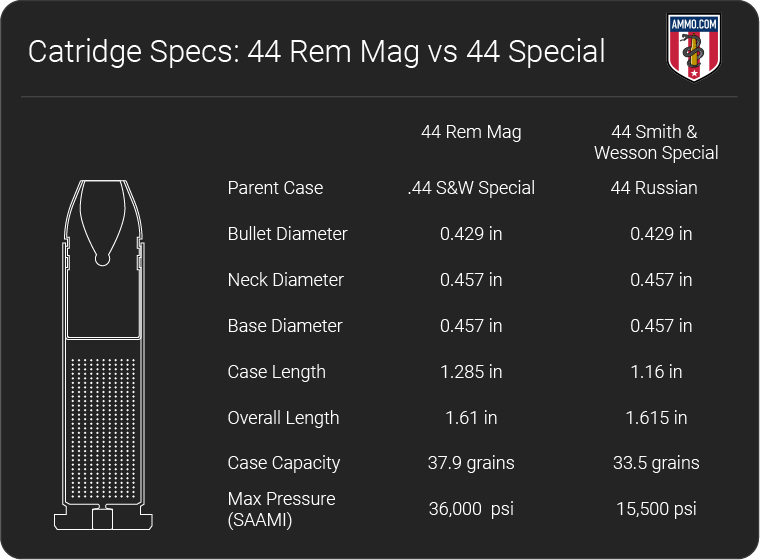
Can You Shoot .44 Special in a .44 Magnum Handgun?
Yes. If you have a .44 Mag, it can safely handle .44 Spl cartridges. In fact, if you want some low recoil practice with your magnum revolver, this is a good way to do it.
However, the opposite isn’t true. Because .44 Magnum cartridges are loaded to much higher pressures, running them through a revolver chambered for .44 Spl could have catastrophic results for both the shooter and the handgun.
Recoil
According to physics, the extra propellant packed into that slightly longer .44 Magnum case should generate more recoil. (That’s Newton’s Third Law for those of us who’ve been out of school for a while. “For every action, there is an equal and opposite reaction.”)
However, the weight of the gun and the weight of the projectile it’s firing also affect the amount of recoil produced.
A heavier handgun will produce less felt recoil, because the mass of the gun absorbs some of that rearward force. Thankfully, manufacturers understand this. That’s why most..44 Magnum handguns have a little more heft than the typical .44 Special.
You can also tame the .44 Magnum's relatively wild recoil by shooting loads with lighter bullets. Shooting heavier bullets causes more buck than shooting lighter bullets.
If we try to get all the exterior factors as close to equal as possible, the .44 Mag still throws some powerful recoil. In comparison, the .44 Special is softer than a newborn kitten.

While plenty of gun guys (and gals) scoff at shooters who complain about recoil, it can have a major effect on accuracy. Heavy recoil not only takes some fun out of the shooting experience but also makes it hard to get back on target. Hefty recoil requires a little extra recovery effort.
Sure, some people handle recoil better than others. However, even the scoffing macho dudes at the gun range will shoot more accurately with a milder recoiling cartridge like the .44 Spl.
Velocity/Penetration
As we said, the .44 Mag has a slightly longer case than the .44 Spl. It’s amazing what a mere 4.4 grains of extra case capacity can achieve. It can increase the muzzle velocity of a 200-grain JHP by 150%.
To ensure we had as close to an apples-to-apples comparison as possible, we looked at Nosler’s load data.

Velocity affects penetration, especially when shooting non-expanding projectiles like jacketed hollow points. Basically, the faster a bullet is traveling when it contacts the target, the deeper it will penetrate.
Velocity also affects bullets designed to deform on impact (think soft points and hollow points). If an expanding bullet hits the target at a slower rate of speed, it may fail to expand.
Deep penetration can be either a blessing or a curse, depending on the scenario. If you need to bust through the tough hide, bone, and muscle of a charging bear, penetration is a good thing. In a self-defense situation, where your children are sleeping on the other side of the wall behind the “bad guy”, too much penetration can have fatal consequences.
Accuracy/Trajectory
Comparing the accuracy of two different cartridges is a tricky affair. Accuracy is a complex formula of ballistics, firearm design, and marksmanship. And the equation leans heavily on shooter skills.
Both the Mag and the Special are used by serious bullseye competitors, which proves both are capable of consistent accuracy.
However, the zippier speed produced by the Magnum definitely gives it an edge in the accuracy/trajectory department. Because the .44 Mag cruises about 1.5 times faster than the .44 Special, it spends less time getting to the target. That means there’s less time for wind and gravity to pull the bullet off course.
At typical self-defense ranges, there isn’t time to see serious bullet drop or wind drift. If you need to stretch the effective range of your pistol or wheel gun, you’ll want to have the .44 Mag on your side.
We should also point out that there are plenty of lever rifles that pack .44 Mag, and the longer barrels definitely support a flatter trajectory and better long-range accuracy.
As we mentioned earlier, the effects of recoil on shooter accuracy shouldn’t be denied. The gentler .44 Special is definitely easier to control, especially when it comes to making accurate follow-up shots.
Kinetic Energy/Stopping Power
“Stopping power” is one of those terms that gets tossed around as shooters try to qualify the effectiveness of certain cartridges. Generally defined as how effectively the round can terminate a threat or drop a game animal, “stopping power” is a complicated subject.
Stopping a human threat and humanely harvesting an animal are two very different things. When a hunter shoots an animal, it may not drop dead in its tracks. However, with a well-placed shot, the animal will eventually succumb to blood loss. As long as the hunter knows how to follow a blood trail, he recovers the animal, and the hunt is still deemed a success.
Shooters in a life-or-death self-defense situation don’t have the luxury of waiting for an armed aggressor to bleed out. Stopping the attacker is the goal here, and that doesn’t necessarily mean death (although that is often the end result).
Successfully stopping a threat depends on shot placement, penetration, number of shots on target, and sometimes the proper alignment of the stars. An aggressor jacked on adrenaline and/or drugs could swat off several shots to center mass and keep charging. Another might decide to rethink his life after a grazing superficial wound.
So, basically “stopping power” is difficult to quantify. However, we can easily track a cartridge’s kinetic energy through the powers of math.
Kinetic energy is equal to half the mass of the bullet times its velocity squared. Because .44 Mag hums along at a significantly higher velocity than .44 Spl, it also carries a ton more kinetic energy with it. When the bullet makes impact, much of that kinetic energy is transferred to the target, sending concussive energy through soft tissue.
Hunting
When choosing a round for hunting, it is important to make sure the cartridge can effectively and ethically harvest whatever game animal you’re pursuing. For hunting, either with a rifle or a handgun, the .44 Remington Magnum is capable of taking even the toughest game animals. However, you won’t want to stretch your shooting range too far. The .44 Mag is a close- to mid-range cartridge.
Most .44 Mag hunting loads leave the barrel with around 1000 ft/lbs of energy. They maintain a good portion of that energy out to 50 yards. Since few handgun hunters risk shots beyond 50 yards, the Mag has enough oomph to handle close-range coyotes, wild boar, black bears, and even whitetail deer.
And because the Mag can be loaded into both handguns and rifles, it can serve as a handy, dual-purpose cartridge.
Another advantage of the .44 Mag is that it is a straight-walled cartridge. The non-necked design makes it a viable option for areas that restrict hunting with necked-down cartridges.
The slower .44 Spl carries less energy. Add that to its limited penetration potential, and the Special isn’t exactly a stellar hunting cartridge. However, I’ve known a few old-timers who claim to have tagged a few whitetails with their Special. The key is good shot placement at close range.
For close-range varmints and small game, the milder .44 Special works just fine.
Self-Defense/Home Defense
When you look at numbers like velocity and kinetic energy, it is apparent that the .44 Mag is a powerful performer. If it’s strong enough to take down a black bear, it can certainly stop two-legged predators.
However, when a heavyweight bullet rips through the air at Magnum velocities, over-penetration can be a serious concern. Too much penetration in a densely populated area, or when loved ones may be on the other side of a door, can cause catastrophic collateral damage.
The Magnum’s substantial recoil also makes getting multiple shots on target quickly a real challenge. In a high-adrenaline situation, taming that wild recoil takes serious muscle and concentration.
Because the .44 Special has mild recoil and more limited penetration potential, it is the safer option for home defense. But is the Special capable of stopping a dangerous threat?
The .44 Spl’s ballistics aren’t too far off from the .45 ACP, which remains a popular option for both law enforcement and civilian personal defense. So, yes, the Special is definitely a viable defensive cartridge.
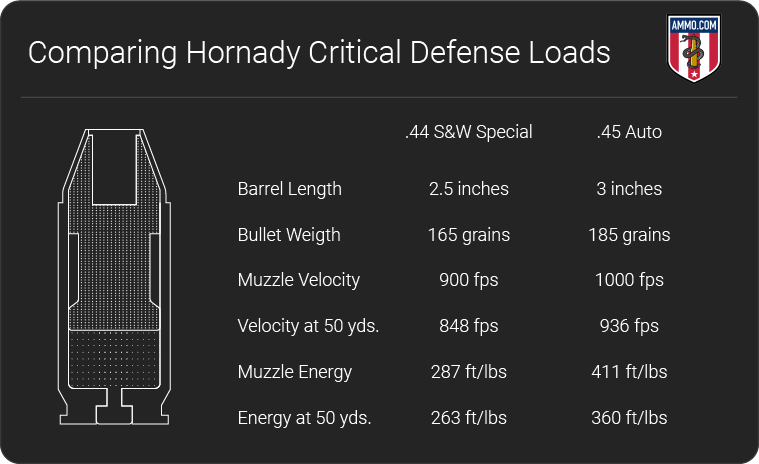
Ammo and Handgun Cost/Availability
The .44 Special was almost completely replaced after .44 Mag hit the ammo scene. However, it has made a resurgence in recent years, although it is still much less popular than its Magnum offspring.
That means there’s plenty more .44 Magnum ammo and firearm variety. You’ll find revolvers and semi-auto pistols chambered in .44 Mag. You can also find .44 Mag bolt-action, break-action, semi-automatic, and lever rifles.
Finding anything other than .44 Special revolver probably isn’t in the cards. However, you can shoot .44 Spl ammo in most .44 Magnum firearms.
The .44 Spl also has a more limited ammo selection. For example, Hornady has a single Special self-defense load compared to four different options for .44 Mag. The vast majority of .44 Spl loads are marketed for cowboy action shooting.
Reloading
Both the .44 Spl and the .44 Magnum are popular cartridges among hand loaders. The selection of .44-caliber bullets is vast, allowing plenty of load customization.
All the major bullet manufacturers, including Sierra, Nosler, and Hornady, have multiple options for .429-inch bullets. And all of them can be used to load both .44 Spl and .44 Mag.
Handloaders can choose from almost every bullet style under the sun. Options range from traditional hard cast to streamlined modern polymer tipped bullets. Available bullet weights range from a relatively meager 180 grains to a super weighty 300 grains.
It is also easy to find fresh brass for both cartridges. While Special cases are usually more expensive than Magnum brass, you can always save your spent brass to save a few bucks.
Ballistics
The team at Ammo.com has collected ballistics data for both the .44 Special and .44 Magnum, so you can easily compare performance data.
.44 Magnum Ballistics
Note: This information comes from the manufacturer and is for informational purposes only. The actual ballistics obtained with your firearm can vary considerably from the advertised ballistics. Also, ballistics can vary from lot to lot with the same brand and type load.
| 44 Magnum Bullet WEIGHT | Muzzle VELOCITY (fps) | Muzzle ENERGY (ft. lbs.) | Mid-Range TRAJECTORY (in.) | Barrel Length (in.) | |||||
|---|---|---|---|---|---|---|---|---|---|
| Muzzle | 50 yds. | 100 yds. | Muzzle | 50 yds. | 100 yds. | 50 yds. | 100 yds. | ||
| 180 Grain | 1610 | 1365 | 1175 | 1035 | 745 | 550 | 0.5 | 2.3 | 4-V |
| 200 Grain | 1296 | 1193 | 1110 | 747 | 632 | 548 | -0.5 | -6.2 | 6" |
| 200 Grain | 1400 | 1192 | 1053 | 870 | 630 | 492 | 0.6 | n/a | 6.5" |
| 200 Grain | 1500 | 1332 | 1194 | 999 | 788 | 633 | n/a | n/a | 7.5" |
| 210 Grain | 1495 | 1310 | 1165 | 1040 | 805 | 635 | 0.6 | 2.5 | 6.5" |
| 225 Grain | 1410 | 1240 | 1111 | 993 | 768 | 617 | n/a | n/a | n/a |
| 240 Grain Medium Velocity | 1000 | 945 | 900 | 535 | 475 | 435 | 1.1 | 4.8 | 6.5" |
| 240 Grain Jacketed | 1180 | 1080 | 1010 | 740 | 625 | 545 | 0.9 | 3.7 | 4-V |
| 240 Grain Lead | 1350 | 1185 | 1070 | 970 | 750 | 610 | 0.7 | 3.1 | 4-V |
| 250 Grain | 1180 | 1100 | 1040 | 775 | 670 | 600 | 0.8 | 3.6 | 6.5-V |
| 250 Grain | 1250 | 1148 | 1070 | 867 | 732 | 635 | 0.8 | 3.3 | 6.5-V |
| 275 Grain | 1235 | 1142 | 1070 | 931 | 797 | 699 | 0.8 | 3.3 | 6.5" |
| 300 Grain | 1150 | 1083 | 1030 | 881 | 781 | 706 | n/a | n/a | 7.5" |
| 300 Grain | 1200 | 1100 | 1026 | 959 | 806 | 702 | n/a | n/a | 7.5" |
.44 Special Ballistics
Note: This information comes from the manufacturer and is for informational purposes only. The actual ballistics obtained with your firearm can vary considerably from the advertised ballistics. Also, ballistics can vary from lot to lot with the same brand and type load.
| 44 S&W Special Bullet WEIGHT | Muzzle VELOCITY (fps) | Muzzle ENERGY (ft. lbs.) | Mid-Range TRAJECTORY (in.) | Barrel Length (in.) | |||||
|---|---|---|---|---|---|---|---|---|---|
| Muzzle | 50 yds. | 100 yds. | Muzzle | 50 yds. | 100 yds. | 50 yds. | 100 yds. | ||
| 165 Grain FTX | 900 | 848 | 802 | 297 | 263 | 235 | n/a | n/a | 2.5" |
| 180 Grain | 980 | n/a | n/a | 383 | n/a | n/a | n/a | n/a | 6.5" |
| 180 Grain | 1000 | 935 | 882 | 400 | 350 | 311 | n/a | n/a | 7.5-V |
| 200 Grain | 875 | 825 | 780 | 340 | 302 | 270 | 1.2 | 6 | 6" |
| 200 Grain | 1035 | 940 | 865 | 475 | 390 | 335 | 1.1 | 4.9 | 6.5" |
| 210 Grain | 900 | 861 | 825 | 360 | 329 | 302 | 5.57 | n/a | 6" |
| 240 Grain | 755 | 725 | 695 | 310 | 285 | 265 | 2 | 8.3 | 6.5" |
| 246 Grain | 755 | 725 | 695 | 310 | 285 | 265 | 2 | 8.3 | 6.5" |
.44 Special Development/History
First introduced in 1907, the .44 S&W Special cartridge was developed specifically as a revolver cartridge for the company’s new Triple Lock wheel gun. Dubbed the New Century, Smith & Wesson designed their new revolver as a nostalgic hat-tip to the big-bore black-powder sidearms (like the Colt Army Revolver) that tamed the American West.
Smith & Wesson released their new wheel gun chambered for a more modern .44-caliber cartridge - the .44 Smith & Wesson Special. Based on the black-powder .44 Smith & Wesson Russian, the Special featured the newest, state-of-the-art smokeless powder.
The first pairings of smokeless powder with the .44 Russian fell flat due to the lower energy density of early smokeless powder. Smith & Wesson engineers addressed the failings by stretching the .44 Russian case by .2 inches to increase its powder capacity.
The original .44 Special load introduced by Smith & Wesson featured a 246-grain round-nose lead bullet backed by a smokeless powder charge equivalent to 26 grains of black powder. The load pushed that hefty projectile out the muzzle at 780 feet per second.
The cartridge reached its prime in the 1950s, when the father of big-bore hand gunning, Keith Elmer, experimented with hotter loads and wadcutter projectiles. He turned what had been almost exclusively a target cartridge into a viable big game hunting cartridge.
Although Keith petitioned ammo manufacturers to offer hotter .44 Special loads for hunting, there was understandable concern about what the higher pressure loads would do to older revolvers.
So instead of offering hotter .44 Specials, the .44 Magnum was born.
.44 Magnum Development/History
The .44 Magnum was the end result of decades of hot .44 Spl hand loads.
Elmer Keith had pushed the envelope for years with ever heavier bullets sent downrange at faster and faster velocities. He offered his hot .44 Special loads through mail order with plenty of success. Keith eventually approached both Smith & Wesson and Remington with his idea of factory loading a hot .44-caliber for big game hunting.
In response, Smith & Wesson developed the first double-action .44 Magnum revolver in 1955. Dubbed the S&W Model 29, it was specially designed to handle the new high-pressure loads. The S&W Model 29 was so popular that it quickly sold out, leaving customers to flock to other .44 Magnum revolvers like the Ruger Redhawk.
Remington engineered the cartridge for the new big-bore wheel gun by lengthening the .44 Spl case. The extra length not only accommodated more propellant but also prevented the high-pressure rounds from fitting in older .44 Spl handguns, eliminating the concern that the traditional wheel guns might not hold up to the new magnum load.
Although the .44 Magnum was originally developed for revolvers, shooters quickly embraced it for rifle shooting.
The .44 Magnum had a surge in popularity in the 1970s after Clint Eastwood’s Dirty Harry character referred to it as “the most powerful handgun in the world.”
The .44 Mag remains one of the most popular big-bore cartridges. It is a particular favorite of handgun hunters because it produces faster velocities and harder-hitting energy than other cartridges with similarly-sized bullets.
Conclusion
While some shooters might dismiss the .44 Spl as outdated, this mild-recoiling big-bore cartridge has more to offer than feelings of nostalgia.
Compared to the hotrod .44 Magnum, the Special delivers fairly sluggish speeds. However, this cartridge is ultra-mild in the recoil department while still providing plenty of accuracy and energy at self-defense ranges. It’s also a favorite of cowboy action shooters and makes a fun plinking tool.
Shooting the mule-kicking .44 Magnum definitely isn’t for the faint of heart. Taming its recoil takes some serious effort. However, this monster speed demon works well for everything from elk to black bear to two-legged predators.
Whether you’re a serious big-game hunter or just a serious recoil junkie, shooting .44 Mag can deliver a major adrenaline rush. If recoil is a turn-off, the .44 Spl is probably the better option.
Ammo Comparisons
- .308 vs 5.56
- 6.5 Creedmoor vs .308
- .300 Blackout vs .308
- .300 Win Mag vs .308
- .243 vs .308
- .308 vs .30-06
- 7mm-08 vs .308
- .270 vs .308
- 7.62x39 vs .308
- .223 vs .308
- .338 Lapua vs .308
- .380 ACP vs 9mm
- .223 vs 5.56
- .300 Blackout vs 5.56
- 9mm vs 45 ACP
- 9mm vs 40 S&W
- .357 SIG vs 9mm
- 10mm vs 9mm
- 9mm vs 9mm Luger
- .243 vs .270
- .300 Win Mag vs .30-06
- .270 vs .30-06
- .40 vs .45
- 38 Special vs 357
- 9mm vs 40 vs 45
- 5.56 vs 7.62x39
- 338 Lapua vs .30-06
- .30-30 vs .30-06
- 300 PRC vs 338 Lapua
- .30-06 vs 7mm
- 300 Win Mag vs 338 Lapua
- 300 PRC vs 300 Win Mag
- 300 WSM vs 300 Win Mag
- 338 Win Mag vs 338 Lapua
- 12 Gauge vs 20 Gauge
- 10mm vs 357 Mag
- .30-30 vs 7.62x39
- 224 Valkyrie vs 22-250
- 17 HMR vs 22 Mag
- 7.62x39 vs .300 Blackout
- 45 ACP vs 45 Auto
- 45-70 vs 30-30
- 300 Blackout vs 223
- 357 Magnum vs 9mm
- 350 Legend vs 300 Blackout
- 224 Valkyrie vs 223
- 45 ACP vs 38 Super
- 6.5 Grendel vs .308
- 17 HMR vs 22 LR
- 10 Gauge vs 12 Gauge
- 22-250 vs 223
- 45 Colt vs 45 ACP
- 350 Legend vs 30-30
- 5.7x28 vs 223
- 5.7 vs 9mm
- 5.56 vs 5.7
- 22 vs 9mm
- Buckshot vs Birdshot
- 450 Bushmaster vs 308
- 450 Bushmaster vs 223
- Buckshot vs Slug
- 6.5 Grendel vs 5.56 vs 223
- 6mm ARC vs 6.5 Grendel
- 44 vs 45
- 458 SOCOM vs 5.56
- 357 vs 44
- 32 ACP vs 380
- 300 Win Mag vs 338 Win Mag vs 338 Lapua Mag
- 450 Bushmaster vs 458 SOCOM vs 50 Beowulf
- 6mm Creedmoor vs 6.5 Creedmoor
- TMJ vs FMJ
- 44 Special Vs 44 Magnum
- 45 90 vs 45 70
- 6.8 Western vs 6.8 SPC
- 50 Beowulf vs 50 BMG
- 26 Nosler vs 6.5 PRC
- 28 Gauge vs 410
- 6.8 SPC vs 5.56
- 6.8 SPC vs 6.5 Grendel
- 6.8 Western vs 7mm Rem Mag vs .28 Nosler
- 6.8 Western vs 6.5 Creedmoor
- 22 Hornet vs 223
- 6.8 Western vs 6.5 PRC
- .410 vs 12 Gauge
- .410 vs 20 Gauge
- 22 LR vs 22 Mag
- 6mm ARC vs 243
- 7mm-08 vs 270
- 243 vs 6.5 Creedmoor
- Nickel vs Brass Casing
- 204 Ruger vs 223
- 50 Beowulf vs 5.56
- 260 Remington vs 6.5 Creedmoor
- 6mm Remington vs 243
- 28 Nosler vs 300 PRC
- 50 Beowulf vs 50 AE
- 22 Nosler vs 22-250
- 450 Marlin vs 45-70
- 300 Win Mag vs 300 Norma
- 458 SOCOM vs 300 Blackout
- 38-55 vs 45-70
- 22 Hornet vs 22 LR
- 300 Norma vs 338 Lapua
- 338 Lapua vs 50 BMG
- 28 Nosler vs 300 Win Mag
- 28 Nosler vs 6.5 Creedmoor
- 204 vs 22-250
- 458 SOCOM vs 45 70
- 44 40 vs 45 70
- 6.8 SPC vs 6.5 Creedmoor
- 450 Bushmaster vs 30-06
- 7mm Rem Mag vs 300 Win Mag
- 30 Carbine vs 223
- 25-06 vs 30-06
- 26 Nosler vs 28 Nosler
- 16ga vs 12ga
- 30 06 vs 7.62 x54R
- 9mm Makarov vs 9mm Luger
- 350 Legend vs 223
- 30 Carbine vs 5.56
- 6.5x55 vs 6.5 Creedmoor
- 6.5 Creedmoor vs 270 vs 25-06
- M193 vs M855
- 450 Bushmaster vs 458 SOCOM
- 6.5 Grendel vs 6.5 Creedmoor
- 350 Legend vs 5.56
- .277 Fury vs 6.8 SPC
- 277 Fury vs 300 Win Mag
- 10mm vs .45 ACP
- 277 Fury vs 223
- 6.8 SPC vs 300 Blackout
- 6.5 PRC vs 6.5 Creedmoor
- 277 Fury vs 308
- 277 Fury vs 6.5 Creedmoor
- 350 Legend vs 450 Bushmaster
- 277 Fury Vs 5.56 NATO
- 10mm vs 40S&W
- 32 ACP vs 9mm
- 32 Special vs 9mm
- 8.6 Blackout vs 300 Blackout
- 30 Super Carry vs. 9mm
- 5.56 vs 9mm
- .50 Action Express vs 9mm
- 7.62x25 vs. 9mm
- 10mm vs 44 Magnum
- 300 Blackout vs 300 Win Mag
- 6.5 Grendel vs 300 Blackout
- 460 Rowland vs 10mm
- 300 RUM vs 300 PRC
- 300 Norma vs 300 PRC
- 45 GAP vs 45 ACP
- 7mm PRC vs 300 Win Mag
- 300 PRC vs 6.5 Creedmoor
- 300 PRC vs 308
- 357 SIG vs 357 Mag
- 7.62x39 vs 7.62x51
- 243 Win vs 223 Rem
- 30 Nosler vs 300 PRC
- 6.5 Creedmoor vs. 30-06 Springfield
- 450 S&W vs. 44 Magnum
- 6.5 Creedmoor vs. 300 Win Mag
- 454 Cassull vs. 45-70 Govt
- 454 Cassull vs. 44 Mag
- 7.62x54r vs. 308 Winchester
- 22 ARC vs. 223 Rem
- Subsonic vs. Supersonic Ammo

